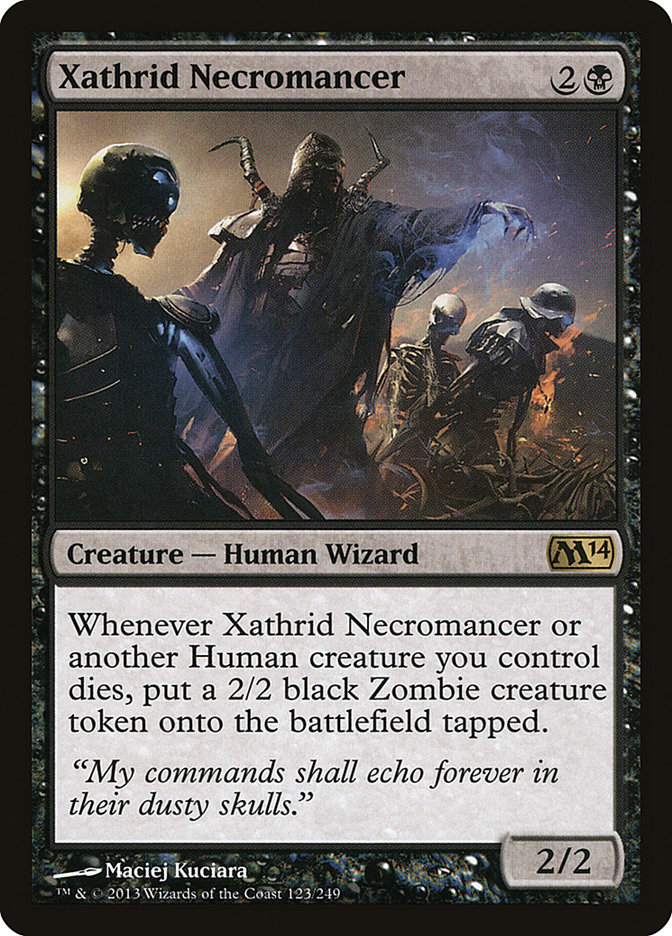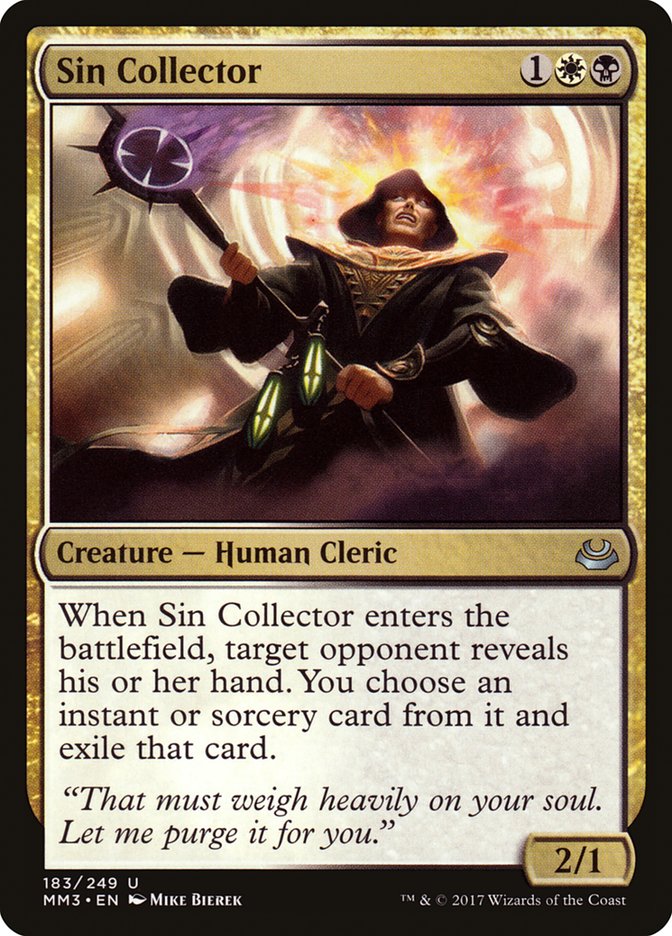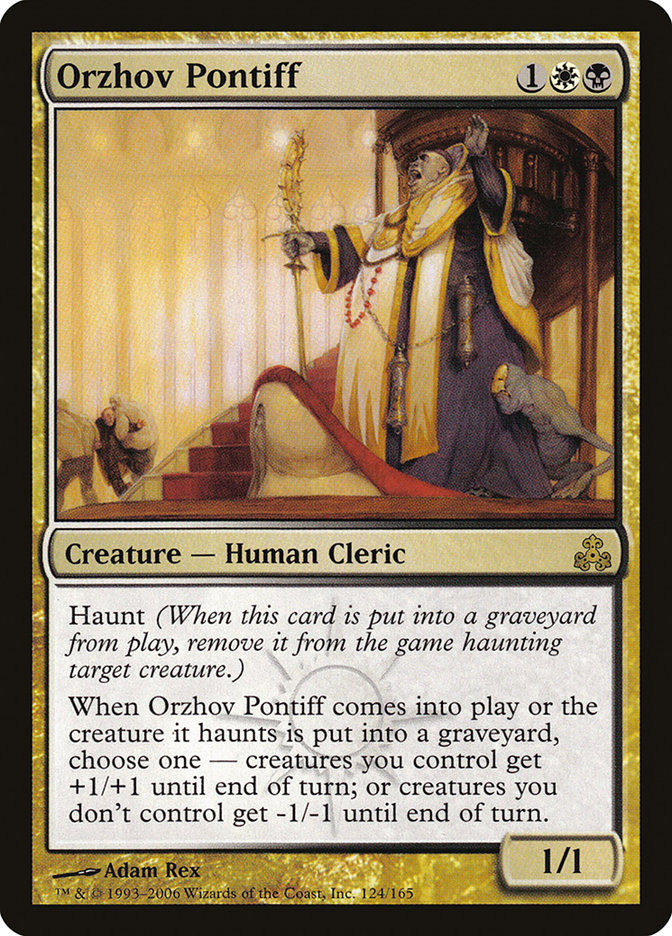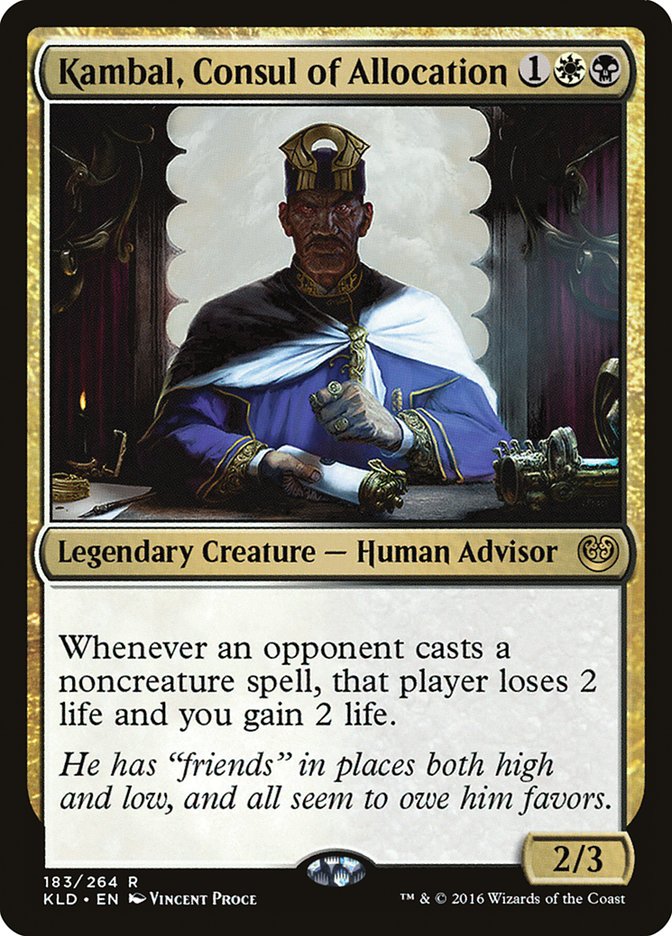The Modern metagame has stabilized with five main decks at the top: Grixis Death’s Shadow, TitanShift, Affinity, Storm, and Eldrazi Tron. Although these are the most consistent top performers right now, there’s a single card that is spawning so many different archetypes that it’s threatening to be the most important card in the format:
We all know how good of a card Collected Company can be, but what’s the right build for the card? There have been so many different Collected Company decks that have been having success recently that it’s challenging to find an optimal build to bring to a tournament. However, if you do find that optimal build, there’s a good chance you’ll be taking home the trophy, because the Collected Company decks have all the tools to take down anything in the vast Modern metagame.
So what Collected Company deck should you play? Well, that’s an incredibly difficult question to answer, so let’s take a look at the different versions of Collected Company decks and their strengths and weaknesses to try to find the answer!
Warning: Abundant Decklists Ahead!
Creatures (28)
- 1 Azusa, Lost but Seeking
- 3 Birds of Paradise
- 2 Eternal Witness
- 2 Aven Mindcensor
- 4 Noble Hierarch
- 4 Knight of the Reliquary
- 1 Qasali Pridemage
- 1 Lotus Cobra
- 4 Voice of Resurgence
- 4 Courser of Kruphix
- 2 Ramunap Excavator
Lands (23)
Spells (9)

Let’s start with the easy one, the G/W Company deck I’ve been playing recently. I’ve already written about the deck a ton recently, but let’s talk about what it does well and what it does poorly.
Strengths: Very strong against any deck that is trying to play fair, and by that I basically mean non-combo decks. Grixis Death’s Shadow, Affinity, and Burn are all very good matchups, along with any three-color midrange deck. Exceptions to this would be TitanShift, Elves, and U/W Control, none of which are necessarily combo decks but not good matchups either. This deck attacks the opponent’s manabase while trying to maximize its own, an angle of attack that is unique to Modern, which means other decks aren’t prepared for it.
Weaknesses: The combo decks. Having a war on manabases is a slow process that other decks can simply ignore and kill you. You have plenty of defense against ground creatures, but decks that are looking to win in other ways and that have plenty of basic lands are very difficult to beat. The two biggest strategies standing in your way are TitanShift and U/R Gifts Storm, and the more concessions you end up making for those two matchups, the more your deck’s core weakens.
Creatures (28)
- 1 Aven Mindcensor
- 4 Tarmogoyf
- 4 Wild Nacatl
- 4 Noble Hierarch
- 3 Knight of the Reliquary
- 2 Qasali Pridemage
- 2 Scavenging Ooze
- 3 Voice of Resurgence
- 1 Tireless Tracker
- 4 Renegade Rallier
Lands (21)
Spells (11)

Naya Company is an almost forgotten option that has some additional tools to fight combo decks. Steven Borakove’s Naya Company list used a full playset of Renegade Rallier to mitigate the weakness that Tarmogoyf has against Fatal Push.
Strengths: Access to Blood Moon. It’s one of the best cards in the current format, and Naya Company gives you not only the ability to play Blood Moon as early as turn 2 but also a reasonably fast clock to back it up with. You also gain more removal than G/W Company has access to in order to keep the small combo creatures such as Goblin Electromancer or Devoted Druid off the battlefield, and Kessig Wolf Run to have your large creatures trample over blockers.
Weaknesses: The manabase is pretty rough in order to play three colors, and you constantly have to fetch up shocklands in the early game to support Wild Nacatl. While Renegade Rallier is normally a solid card, there are times that revolt is difficult to trigger and that it has a small impact on the game. Removal-heavy decks can be problematic, and Rest in Peace is incredibly hard to beat.
I would definitely recommend having access to a third Blood Moon in the sideboard with how vital it is against TitanShift and still good in many other places. While Thalia, Guardian of Thraben is a good card against Storm, it’s not impactful enough to be worth the space in the sideboard. I would rather have access to Ethersworn Canonist and an efficient planeswalker like Domri Rade. Naya Company is a good choice against many of the top decks of the format but is one of the weakest options against all of the other Collected Company decks.
Creatures (31)
- 4 Noble Hierarch
- 4 Champion of the Parish
- 3 Avacyn's Pilgrim
- 1 Mayor of Avabruck
- 4 Thalia, Guardian of Thraben
- 2 Sin Collector
- 1 Anafenza, the Foremost
- 1 Abzan Falconer
- 4 Reflector Mage
- 4 Thalia's Lieutenant
- 3 Thalia, Heretic Cathar
Lands (21)
Spells (8)

An emerging archetype that we have seen have some success on Magic Online and now in paper is Humans Company, a four-color deck that plays similarly to traditional Zoo decks by using large creatures and just enough interaction to get the job done.
Strengths: Champion of the Parish and Thalia’s Lieutenant are crazy-good cards and can create some ridiculously large creatures very quickly. With access to both Reflector Mage and Thalia, Heretic Cathar, blocking can be almost impossible for your opponent, making other creature matchups favorable. The quicker clock is useful at beating combo decks, and maindeck Sin Collector as well as Kambal, Consul of Allocation in the sideboard shore up those matchups as well.
Weaknesses: Pitiful manabase. A good sign that something is wrong is when you’re resigned to playing Mana Confluence. We’re playing blue in this deck basically just for Reflector Mage, and although that card is an all-star in creature matchups, I can’t believe it’s necessary to win those. With the damage having to splash blue does to the manabase, I don’t think it’s worth it. I would rather have a traditional fetchland/shockland manabase and then be able to play Knight of the Reliquary instead of Anafenza, the Foremost. Thalia, Guardian of Thraben is an average card at best, and without other disruption it isn’t good enough, but the options for Human two-drops aren’t ideal. The cards in the deck have a very high power/toughness rate, but die easily to removal, and therefore control decks are a real problem.
Some versions of this deck online have had Xathrid Necromancers in the three-drop slot over so many Thalia, Heretic Cathars and I like that change. Xathrid Necromancer is an incredibly powerful card against Supreme Verdict, which is probably the best card in the format against you. With the little that blue added to the deck and wanting to change the manabase, I took this shell and turned it into Abzan Humans.
Creatures (30)
- 1 Eternal Witness
- 4 Noble Hierarch
- 3 Knight of the Reliquary
- 1 Mirran Crusader
- 4 Champion of the Parish
- 2 Avacyn's Pilgrim
- 4 Mayor of Avabruck
- 1 Sin Collector
- 3 Xathrid Necromancer
- 4 Thalia's Lieutenant
- 1 Tireless Tracker
- 2 Renegade Rallier
Lands (22)
Spells (8)

Renegade Rallier is another Human, and I wanted to try it out with the ability to get a Thalia’s Lieutenant back onto the battlefield. I also wanted to play more Mayor of Avabrucks to also get back with Renegade Rallier, as, even though they are quite fragile, Howlpack Alpha allows the deck to not overextend against control decks. Tireless Tracker and Eternal Witness further improve the control matchups, and now the deck has more card advantage than the previous versions, but control decks are still difficult to beat.
I’ve been extremely impressed with all four of these creatures, so much so that I wouldn’t mind having them all maindeck in order to free up a ton of valuable sideboard slots. It’s entirely possible that Knight of the Reliquary and Renegade Rallier aren’t as good as these creatures in this deck, and the manabase can then have more Blooming Marsh and Razorverge Thicket instead of the amount of fetchlands. It’s what I’ll be testing next, but so far Abzan Human Company has been very promising.
Creatures (29)
- 2 Eternal Witness
- 4 Noble Hierarch
- 4 Knight of the Reliquary
- 4 Champion of the Parish
- 4 Avacyn's Pilgrim
- 2 Mayor of Avabruck
- 1 Thalia, Guardian of Thraben
- 4 Reflector Mage
- 4 Thalia's Lieutenant
Lands (21)
Spells (10)

Another option for playing a Humans Company deck is to simply play Bant and have access to the Knight of the Reliquary and Retreat to Coralhelm combo, and this could easily be the best option for Champion of the Parish decks.
Strengths: This deck takes more advantage of Retreat to Coralhelm than other Bant Knightfall decks because it can be used aggressively to clear blockers for Champion of the Parish. The Retreat to Coralhem and Knight of the Reliquary combo is also one of the best ways for a Collected Company deck to beat combo decks, so with the already fast clock paired with the combo, you have a real chance to win every game you play. Izzet Staticaster in the sideboard is a wonderful all-around card.
Weaknesses: The combo matchups still aren’t favorable post-sideboard, however, and I think we need some more for them in the sideboard. Again, Thalia, Guardian of Thrabens is still a poor card and needs to be replaced in the sideboard with something that is better against specifically TitanShift. The U/R Gifts Storm matchup is already pretty favorable. There’s not a chance that Vithian Renegades is the best option for the sideboard, and even though Reclamation Sage isn’t a Human, it’s much easier to cast and can destroy enchantments. Like the other Human Company decks, I would look for ways to improve the TitanShift and U/W Control matchups.
Creatures (27)
- 4 Birds of Paradise
- 2 Kitchen Finks
- 4 Noble Hierarch
- 4 Knight of the Reliquary
- 1 Qasali Pridemage
- 3 Tireless Tracker
- 3 Thalia, Heretic Cathar
- 4 Spell Queller
- 2 Selfless Spirit
Lands (23)
Spells (10)

Traditional Bant Knightfall is the usual go-to deck that is built around the Knight of the Reliquary and Retreat to Coralhelm combo, and Joao Lelis won GP Sao Paulo recently with the deck. Most people only play one or maybe two Retreat to Coralhelms, and I actually like how Joao played three because I’ve always felt the card has been underrated on its own.
Strengths: Spell Queller, Knight of the Reliquary, and Tireless Tracker. All three of these creatures are extremely powerful on their own, meaning you don’t need to rely on synergies to take down games. There are decks that fold to Spell Queller, especially Game 1, and Tireless Tracker can allow you to outpace control decks. I really like taking Reflector Mage out of the deck because there are too many matchups that it is ineffective against in my opinion. The sideboard is built to beat two decks in particular: Eldrazi Tron and TitanShift. This is absolutely the best Collected Company deck against TitanShift, so if you want to beat that then start here.
Weaknesses: Honestly there aren’t a lot of weaknesses as far as matchups go here, which is why Joao Lelis won the Grand Prix. There are tools to beat basically everything in the format with this deck, but you can struggle with matchups if you don’t draw the wrong cards. The biggest thing about the list that needs to change is taking out the Mirran Crusaders. Mirran Crusader was a trump card against Grixis Death’s Shadow a few weeks ago, but not anymore, as they have adapted to be able to beat it. I’m also not much of a fan of Thalia, Heretic Cathar, and can’t imagine wanting to play three copies. I would prefer to play some number of Eternal Witness and/or Voice of Resurgence instead in that slot.
Creatures (32)
- 4 Birds of Paradise
- 4 Eternal Witness
- 4 Devoted Druid
- 3 Kitchen Finks
- 4 Noble Hierarch
- 1 Viscera Seer
- 1 Scavenging Ooze
- 4 Duskwatch Recruiter
- 2 Renegade Rallier
- 1 Walking Ballista
- 4 Vizier of Remedies
Lands (20)
Spells (8)

The current most popular Collected Company deck of all, Counters Company rarely wins through attacking and instead has uses multiple combos to win the game, most commonly by gaining an arbitrarily large amounts of mana from the Devoted Druid and Vizier of Remedies combo.
Strengths: You can win as early as turn 3 with some decent redundancy, making it easy to beat most decks that don’t interact with you. Eternal Witness also provides plenty of card advantage when your opponents do try to interact with you, and because of playing four Eternal Witneses, you virtually have the most Collected Company copies in your deck in the format. The abundance of Kitchen Finks in the deck makes your Burn matchup incredibly favorable, and Chord of Calling allows you to consistently find your sideboard bullets.
Weaknesses: Control and removal. The more your opponents play, the harder it is for you to win. Because your deck is so focused on comboing, the power level of many of the individual cards is laughably bad. If your opponent can keep your combos broken up, it’s unlikely that the rest of the cards in your deck will be good enough to win. The maindeck also has virtually no interaction for the opponent, so you can’t slow down other combo decks if they have a faster hand.
Creatures (31)
- 3 Birds of Paradise
- 4 Eternal Witness
- 4 Devoted Druid
- 4 Noble Hierarch
- 4 Knight of the Reliquary
- 3 Reflector Mage
- 1 Tireless Tracker
- 2 Duskwatch Recruiter
- 1 Walking Ballista
- 4 Vizier of Remedies
- 1 Ramunap Excavator
Lands (21)
Spells (8)

If you want to play Counters Company but also like Knight of the Reliquary, you can just put the combos in the same deck!
Strengths: You get to play the Counters Company combo but also have a much better chance at beating removal-heavy midrange decks. The number of must-answer threats in this deck is incredibly high, and untapping with either Devoted Druid or Knight of the Reliquary can be an instant win on the spot. Unified Will and Izzet Staticaster are both wonderful cards to have access to in different matchups, and you most likely have a very high win percentage against the many fringe decks of the format.
Weaknesses: Reflector Mage looks out of place here because you aren’t too interested in winning the game through combat damage most of the time. Your deck doesn’t combo as consistently as Counters Company and you don’t have the interaction that Bant Knightfall has, so you are somewhat stuck in the middle. Nissa, Steward of Elements is a card I’ve never been impressed with and believe should be something else, but I can see the allure of casting it on turn 2 against a control deck.
Creatures (35)
- 4 Llanowar Elves
- 1 Eternal Witness
- 4 Heritage Druid
- 4 Devoted Druid
- 4 Nettle Sentinel
- 1 Elvish Visionary
- 4 Elvish Archdruid
- 4 Ezuri, Renegade Leader
- 4 Elvish Mystic
- 4 Dwynen's Elite
- 1 Vizier of Remedies
Lands (17)
Spells (8)

Elves isn’t too much like the rest of the Collected Company decks, but it’s still an incredibly powerful deck. It’s not the easiest to play, but the explosiveness it can provide is unreal.
Strengths: Not many people build their decks with beating Elves in mind because it’s such a small part of the metagame, which is a plus for you. The deck mulligans very well because you don’t need many resources to win; you just need the right cards. Having the Devoted Druid combo or simply a few Elves plus Elvish Archdruid will most likely suffice. You’re a lean combo deck that can race anything in the format.
Weaknesses: Sweepers. The best cards for beating Elves are the various Wrath effects from Anger of the Gods to Supreme Verdict. Elves usually goes wider than any other deck, and keeping them contained is the name of the game. U/W Control is as popular as it ever has been, which isn’t a good sign for Elves, and there are many TitanShift players bringing Anger of the Gods to the table. If Grixis Death’s Shadow continues to put more sweepers in their sideboard, which it looks like they are, that’s only bad news for Elves players. However if your opponent isn’t packing sweepers there’s a good chance you’re going to overwhelm them.
Ross Merriam had a wonderful weekend playing Elves at #SCGRICH, and if you want to know more about the deck and what he recommends playing, check out this article.
Infinite Company
The options are seemingly endless when it comes to playing Collected Company in Modern, and the people who do well with the different archetypes are those who are familiar with their build and have a plan. That’s honestly the most important thing, and over time when there are more people getting used to playing these Collected Company decks, I think we will start to see some more refined decklists. For now, though, it’s the Wild West, where you can pair basically anything with Collected Company and do well. For me, I’m going to be playing all of these decks leading up to #SCGKY next month, because I think the best deck in Modern is a Collected Company one.
I just need to find it.






